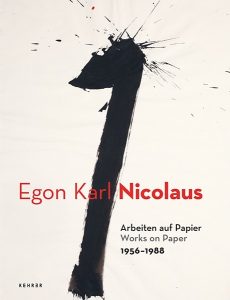Egon Karl Nicolaus’s Zahlenbilder.
©2017 Kehrer Verlag Heidelberg Berlin, Egon Karl Nicolaus Stiftung, authors and photographers [and translators] ISBN 978-3-86828-692-2
The Oeuvre on Paper, by Ralf-P. Seippel
In the pictorial oeuvre of Egon Karl Nicolaus, the works on paper, also and in particular in respect of their quality, are on an entirely equal footing with the works on canvas. There is an abundance of drawn, constructive graphic and, above all, pictorial painted works from all phases of his work. Paper as a medium served him for artistic experimentation as well as for the finished and consummate work.
The sheer abundance of works on paper results, on the one hand, from cramped living and studio conditions and, on the other, from the fact that Egon Karl Nicolaus worked almost exclusively on paper when travelling. This hitherto little-known and rarely acknowledged integral part of his artistic output is comprehensively presented in the present publication and accompanying exhibition of works for the first time.
(… …)
Whereas the works circa the mid-1950s (pp. 20ff) were still bound to the tradition of Bauhaus and, following the ideas and styles of the time, to the vertical line and the relation between line and upright rectangular shape, and the painterly gesture was reduced to a minimum, there was a change to the opposite from 1959 onwards (pp. 28/29). The Informal Art of Germany, the Abstract Expressionism of the USA and the Tachism of France show their impact in the work of Egon Karl Nicolaus as well. Ductus, movement, a kind of lyrical abstraction becomes visually determinative.
(… …)
Karl Egon Nicolaus found, assumed and upheld a clear artistic position. In the number, he found for himself the motif that enabled him to work purely abstractly and nevertheless give the beholder a connotation of everyday reality. Nothing is inherently more abstract and concrete, simultaneously, than the number. He adapts the number in and through his visual language over the years, and yet one must not reduce the oeuvre to the number, for in his pictures the vertical and horizontal lines alike are straight, parallel, diagonal or curved, and often compositionally interwoven through the use of paint as well (pp. 106 ff.). Therefore, they could be perceived purely abstractly, were the association ‘number’ not to impose itself straight away. It becomes clear, at the same time, how difficult one finds it to let go of the number, how extremely it has taken us over, how extremely it determines our perception and consciousness.
However, if the beholder succeeds in discovering for herself or himself this opportunity for purely abstract observation, an additional, new perspective on the work of Egon Karl Nicolaus will be revealed.
